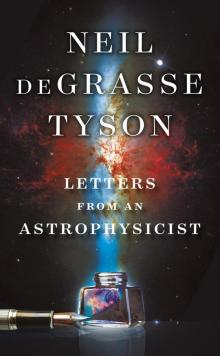- Home
- Neil DeGrasse Tyson
The Pluto Files: The Rise and Fall of America's Favorite Planet
The Pluto Files: The Rise and Fall of America's Favorite Planet Read online
The Pluto Files
ALSO BY NEIL DEGRASSE TYSON
DEATH BY BLACK HOLE AND OTHER COSMIC QUANDARIES
(2007)
THE SKY IS NOT THE LIMIT: ADVENTURES OF AN URBAN ASTROPHYSICIST
(2004)
ORIGINS: FOURTEEN BILLION YEARS OF COSMIC EVOLUTION
(with Donald Goldsmith)
(2004)
MY FAVORITE UNIVERSE
(a 12-part video lecture series)
(2003)
COSMIC HORIZONS: ASTRONOMY AT THE CUTTING EDGE
(with Steven Soter, eds.)
(2001)
ONE UNIVERSE: AT HOME IN THE COSMOS
(with Charles Liu and Robert Irion)
(2000)
JUST VISITING THIS PLANET
(1998)
MERLIN’S TOUR OF THE UNIVERSE
(1997)
UNIVERSE DOWN TO EARTH
(1994)
Neil deGrasse Tyson
THE PLUTO FILES
THE RISE AND FALL OF AMERICA’S FAVORITE PLANET
W. W. NORTON & COMPANY
NEW YORK LONDON
Copyright © 2009 by Neil deGrasse Tyson
All rights reserved
For information about permission to reproduce selections from this book, write to Permissions, W. W. Norton & Company, Inc., 500 Fifth Avenue, New York, NY 10110
Library of Congress Cataloging-in-Publication Data
Tyson, Neil deGrasse.
The Pluto files: the rise and fall of America’s favorite planet / Neil deGrasse Tyson.
p. cm.
Includes bibliographical references.
ISBN: 978-0-393-07334-8
1. Pluto (Dwarf planet) I. Title.
QB701.T97 2009
523.49'22—dc22
2008040436
W. W. Norton & Company, Inc.
500 Fifth Avenue, New York, N.Y. 10110
www.wwnorton.com
W. W. Norton & Company Ltd.
Castle House, 75/76 Wells Street, London W1T 3QT
To Plutophiles young and old
Letter from Taylor Williams, Mrs. Koch’s second-grade class, Roland Lewis Elementary School, Tampa, Florida (spring 2008).
Contents
PREFACE
1. Pluto in Culture
2. Pluto in History
3. Pluto in Science
4. Pluto’s Fall from Grace
5. Pluto Divides the Nation
6. Pluto’s Judgment Day
7. Pluto the Dwarf Planet
8. Pluto in the Elementary School Classroom
A Personal Recommendation for Educators
9. Plutologue
APPENDIX A Pluto Data (2008)
APPENDIX B “Planet X” (complete lyrics by Christine Lavin)
APPENDIX C “I’m Your Moon” (complete lyrics by Jonathan Coulton)
APPENDIX D “Pluto’s Not a Planet Anymore” (complete lyrics by Jeff Mondak and Alex Stangl)
APPENDIX E Official Media Response from the Author Regarding the Rose Center’s Exhibit Treatment of Pluto
APPENDIX F Resolution of the International Astronomical Union on the Definition of a Planet
APPENDIX G New Mexico Legislation Relative to Pluto’s Planetary Status
APPENDIX H California Legislation Relative to Pluto’s Planetary Status
BIBLIOGRAPHY
ACKNOWLEDGMENTS
CREDITS
Preface
GATHERED HERE IN ONE PLACE IS A RECORD OF PLUTO’S RISE AND fall from planethood, given by way of media accounts, public forums, cartoons, and letters I received from disgruntled schoolchildren, their teachers, strongly opinionated adults, and colleagues.
In February 2000, the American Museum of Natural History opened its $230 million Frederick Phineas and Sandra Priest Rose Center for Earth and Space, containing the rebuilt Hayden Planetarium, on the corner of 81st Street and Central Park West in New York City. The newly conceived exhibits treated the solar system in a way that was without precedent for public institutions, even though murmurs had already begun in the planetary science community that something needed to be done about Pluto’s classification in the solar system.
The exhibit models, their accompanying text, and the overall layout of the Rose Center organized the principal contents of the solar system by objects of like properties, rather than as enumerations of planets and their moons. This decision landed Pluto among the growing number of icy objects found beyond Neptune and left it unmentioned and out of view among our models for the rocky, terrestrial objects (Mercury, Venus, Earth, and Mars) and the gas giants (Jupiter, Saturn, Uranus, and Neptune). By this organization, we practically abandoned the concept of planet altogether.
This decision represented the consensus of the science committee for the Rose Center’s design and construction, of which I served as head. While the accountability and originality of our pedagogical approach to the subject lies equally among us on the committee, as director of the Hayden Planetarium I became the most visible exponent of this decision when, a full year after the Rose Center opened to the public, the New York Times broke a page 1 news story that we had “demoted” Pluto from its ranks of planethood. I was thenceforth branded a public enemy of Pluto lovers the world over.
This distinction prevailed until August 2006, when the International Astronomical Union (IAU), prompted by pressure from the professional community of planetary scientists as well as from the general public, brought Pluto’s planethood to a vote at a triennial general assembly in Prague, Czech Republic. The result? Pluto was formally downgraded from “planet” to “dwarf planet,” thereby helping to diffuse the negative attention that we had been receiving for six years running.
It’s one thing for a single institution to reexamine Pluto’s standing in the solar system, but it’s quite another for an international organization of astronomers to do so. When the IAU voting results were released, a media frenzy followed, temporarily displacing news stories on terrorism, the Iraq War, genocide in Darfur, and global warming.
The Pluto Files chronicles and documents Pluto’s remarkable grip on the hearts and minds of the American public, the professionals, and the press.
Neil deGrasse Tyson
New York City
October 2008
The Pluto Files
1
Pluto in Culture
AT ABOUT FOUR IN THE AFTERNOON ON FEBRUARY 18, 1930, 24-year-old Clyde W. Tombaugh, a farm boy and amateur astronomer from Illinois, discovered on the sky what would shortly be named for the Roman god of the underworld. Tombaugh had been hired by Arizona’s Lowell Observatory to search for the mysterious and distant Planet X. The observatory was named and founded in 1894 by Percival Lowell, an independently wealthy American astronomer, who died in 1916, but not before launching the search that Tombaugh would complete. On March 13, 1930, Lowell Observatory went public with the news.
Shortly thereafter, two well-known architectural icons were out-of-date the day they were dedicated. On May 12, 1930, a mere two months after Pluto’s discovery, the Adler Planetarium, on Chicago’s South Lake Shore Drive, opened for business—the first of its kind in the Western Hemisphere1 and today the oldest surviving planetarium in the world. Adler’s ornate entrance lobby had been designed well before Pluto’s discovery and displays a circle of plaques affixed to the wall that duly identifies a Plutoless family of eight planets in the solar system.
And in New York City, between Fiftieth and Fifty-first streets along Fifth Avenue, you will find, across the avenue from the main entrance to Saint Patrick’s Cathedr
al, a large and mighty brass statue of Atlas, designed by the sculptor Lee Lawrie in the 1920s and erected in the 1930s as part of the extensive art deco Rockefeller Center complex. You may remember from mythology class that for his misdeeds, Atlas was condemned by Zeus to stand on Earth’s western edge and hold the entire sky on his shoulders, preventing Earth and sky from resuming their primordial embrace. To represent the sky, Lawrie molded a spherical celestial grid, as is common for such artistic needs. But across Atlas’s yoke, Lawrie identified the symbol for each of the planets, Earth’s Moon included, lest you were not yet convinced that the known universe is what Atlas carried. Of course, in the 1920s Pluto had not yet been discovered, so once again Pluto was too late for the party. Atlas’s yoke identifies Mercury through Neptune, with no room for a ninth planet. No room for Pluto.
The world of music would be similarly afflicted.
In search of cosmic themes for his next orchestral work, the English composer Gustav Holst (1874–1934) wrote his seven-movement master-piece The Planets in 1916. Holst drew his musical themes from the lives and times of the Roman mythological characters after whom the planets were named. Of course, the music is absent a movement dedicated to Pluto, which had not yet been discovered, and it’s missing Earth, which was not a classical planet, leaving a count of only seven.
Figure 1.1. Adler Planetarium, Chicago. It was dedicated only two months after the announcement of Pluto’s discovery.
Figure 1.2. The sunlit, spectrum-graced entrance foyer to the Adler Planetarium, in Chicago. Planetarium CEO Paul Knappenberger (left) and the author flank the eight bas-relief plaques from 1930, one for each planet of the solar system—except Pluto, which had not been discovered at the time the plaques were designed and cast.
Figure 1.3. The statue of Atlas stands tall and mighty, in art deco splendor, along Fifth Avenue at Rockefeller Center, in New York City. The solar system labeled across his shoulders is missing Pluto. The statue was designed by Lee Lawrie in the 1920s, before Pluto was discovered.
Figure 1.4. Atlas, detail. Rising above Atlas’s six-pack abs and his bulging biceps we see the yoke that displays in relief the eight planets of the solar system, plus the Moon. From right to left we have the symbols for Mercury, Venus, Moon + Earth, Mars, Jupiter (eclipsed by Atlas’s linebacker neck), Saturn, Uranus, and finally Neptune.
Shortly after Clyde Tombaugh’s discovery, Holst began working on a Pluto movement, inspired, of course, by themes of the underworld. He partially completed the work before suffering a stroke. But after an effort to dictate the rest of the movement to one of his students, Holst (with unwitting foresight for Pluto’s fate) abandoned the effort, unhappy with how the work was turning out.
Not letting the music of the spheres rest, composer and Holst scholar Colin Matthews wrote the “missing” Pluto movement in 2000 for the Manchester-based Hallé Orchestra. But with Pluto’s 2006 demotion to the status of “dwarf planet,” Matthews’s notes, though well meaning, might better serve as the first movement of a yet-to-be-written orchestral work that celebrates the exotic icy bodies of the outer solar system.
While Clyde Tombaugh was searching for Planet X, the roaring twenties was in full swing. At the time, most Americans associated the name Pluto with the commercial product Pluto Water, a heavily advertised and widely used mineral water laxative. Promising “Relief for Constipation in 30 minutes to 2 hours,” Pluto Water was bottled on the grounds of the palatial French Lick Springs Hotel in Indiana, about 50 miles south of Bloomington. In a hard-to-forget slogan, the Pluto Water ads further proclaimed, “When Nature Won’t—Pluto Will.” So you wouldn’t have expected Americans of the day to come up with the name Pluto for the newly discovered cosmic object. And they didn’t.
Percival Lowell’s widow, Constance, proposed the name Percival for the new object, which would sound odd to many astronomers’ ears. Yet this gesture was not the first expression of cosmic audacity in the history of planet names. After the English astronomer William Herschel (1738–1822), who we will learn more about later, was convinced he had discovered a real planet in 1781 (the first ever discovered by anyone), he did what any good citizen of an aristocracy would do: he named his new planet after King George III. For years, the planets of the solar system would be identified as Mercury, Venus, Earth, Mars, Jupiter, Saturn, and Georgium Sidus. I don’t know about you, but I find something fiunsettling about a planet named George, even if he is a king. Apparently, so did everybody else. Eventually, the Roman nomenclature was resumed, leading to the name Uranus, Roman god of the sky, and son and husband of mother Earth.
Figure 1.5. A 1932 advertisement for Pluto Water, a popular laxative in America around the time Pluto the planet was named by an 11-year-old girl from England.
By tradition, dating back to Galileo in the early 1600s, planet moons are named for Greek mythological characters in the life of the Greek god whose Roman counterpart is the name of the planet itself. For example, the four brightest moons of Jupiter—Io, Ganymede, Callisto, and Europa—are characters in the life of the Greek god Zeus, for whom Jupiter is the Roman counterpart. But in the lone exception to this rule, partly appeasing the British people, who were dissed by not having a planet they discovered named for their king, the moons of Uranus are named for characters in Shakespearean plays. Among them we find Ariel, Caliban, and Miranda (all from The Tempest), Oberon and Puck (both from A Midsummer Night’s Dream), and Bianca (from The Taming of the Shrew).
The name Pluto was first suggested over breakfast on Friday, March 14, 1930, by Venetia Burney, an 11-year-old schoolgirl in Oxford, England, after her grandfather had read the news story that Lowell Observatory discovered a new planet. Unlike Americans across the Atlantic, Venetia probably never used or even heard of Indiana’s Pluto Water laxative, leaving her free from scatological bias against the name. She had been studying classical mythology in school and of course knew the other planets. With the name Pluto not yet taken, she blurted out to her grandfather, “Why not call it Pluto?,”2. knowing that Pluto is, after all, the god of the dead and underworld, the realm of darkness. And what else, if not darkness, prevails 4 billion miles from the Sun?
The rest is history. Or rather, good luck. Venetia’s grandfather, Falconer Madan, was a retired librarian from the Bodleian Library of Oxford University who happened to be friends with many astronomers. Madan suggested the name to Herbert Hall Turner, Oxford professor and former astronomer royal (who, among other credits, coined the term parsec),3. and Turner promptly cabled the name to fellow astronomers at the Lowell Observatory.
Figure 1.6. Venetia Burney, an 11-year-old schoolgirl in Oxford, England, first suggested the name Pluto after her well-connected grandfather had read the news story of Lowell Observatory’s discovery of a planet. She had been studying classical mythology, and Pluto, the god of the underworld, was fresh in her mind.
Other suggestions for names included Artemis, Atlas, Constance, Lowell, Minerva, Zeus, and Zymal. But Pluto eventually triumphed. The name also maintains a happy family with Jupiter and Neptune as Pluto’s brothers in Roman mythology.
Apparently, the naming of cosmic objects was already in Venetia’s bloodline. Her great-uncle, Henry Madan, was science master of Eaton College in 1877 when he named the two newly discovered moons of Mars—Phobos (Fear) and Deimos (Terror)—after the battle companions to Ares, the Greek god of war. Venetia Burney ultimately became Venetia Burney Phair and worked as an economics teacher before retiring to her home in Epsom, England.
Lowell Observatory officially proposed the name Pluto on May 1, 1930, in simultaneous letters to the American Astronomical Society, the Royal Astronomical Society, and the New York Times. Pluto’s official symbol would be the overlapping, juxtaposed letters P and L, the first two letters of Pluto and, in a happy coincidence, the initials of Percival Lowell, who instigated the search in the first place.
Eleven years later, in 1941, a team of physicists led by Glen T. Seaborg manufactured a new element for the Periodic Table (y
ou may remember this ubiquitous grid of boxes from chemistry class) while working at the University of California at Berkeley’s cyclotron—one of the world’s pre-eminent atom smashers. The new element had 94 protons in its nucleus and was in need of a name. There, in the outer solar system, the newly discovered planet loomed large. Thus was born plutonium. This fissionable element became the active ingredient in the atomic bomb that the U.S. Army Air Force dropped over the Japanese city of Nagasaki on August 9, 1945, just weeks after the bomb had been tested on July 16, 1945, at the Trinity test site in New Mexico—the first-ever detonation of a nuclear weapon. The one dropped over Hiroshima on August 6 was not pretested. It used uranium, whose bomb-worthy fissionable properties had been well established on paper and in the laboratory.
Figure 1.7. Herbert Hall Turner, Oxford professor and former astronomer royal, promptly cabled the name Pluto to fellow astronomers across the Atlantic at the Lowell Observatory after hearing the suggestion from 11-year-old Venetia Burney, via her grandfather, Falconer Madan, a retired librarian from the Bodleian Library of Oxford University.
In hindsight, plutonium was destined to be named for Pluto. By 1789, just eight years after Herschel discovered Uranus, Martin Klaproth, of Germany, discovered the heaviest atom in nature. In need of a name, and with the planet Uranus fresh on people’s minds, the element uranium would ultimately land at slot 92 on the periodic table, harboring 92 protons in its nucleus.
Before you even discovered the next element in sequence, what would you want to name it? Berkeley physicists Edwin M. McMillan and Philip H. Abelson discovered element number 93 in 1940 and duly named it neptunium after planet Neptune, thus mirroring the sequence of element names to the run of planet names in the outer solar system, leaving plutonium to follow naturally thereafter.

 Letters from an Astrophysicist
Letters from an Astrophysicist Accessory to War
Accessory to War The Pluto Files: The Rise and Fall of America's Favorite Planet
The Pluto Files: The Rise and Fall of America's Favorite Planet Death By Black Hole & Other Cosmic Quandaries
Death By Black Hole & Other Cosmic Quandaries